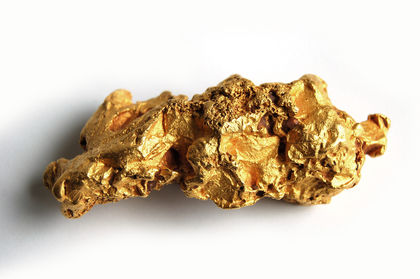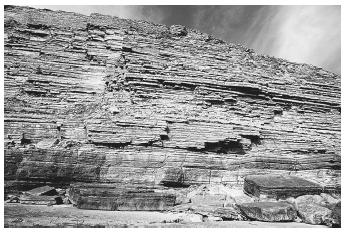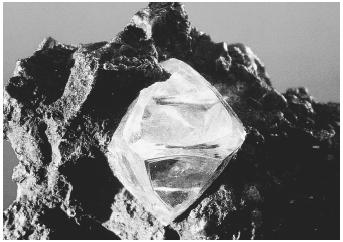Minerals

Minerals are the building blocks of rocks. A mineral may be defined as any naturally occurring inorganic solid that has a definite chemical composition (that can vary only within specified limits) and possesses a crystalline structure. The study of minerals is known as mineralogy, which dates back to prehistory. The use of minerals in the construction of primitive weapons and as suppliers of color for ancient artists makes mineralogy one of the oldest of the human arts.
Minerals may be characterized by the fundamental patterns of their crystal structures. A crystal structure is commonly identified by its fundamental repeating unit, which upon protraction into three dimensions generates a macroscopic crystal. Crystal structures can be divided into crystal systems, which can be further subdivided into crystal classes—a total of thirty-two crystal classes, which are sometimes referred to as point classes.
More commonly, minerals are described or classified on the basis of their chemical composition. Although some minerals, such as graphite or diamond, consist primarily of a single element (in this instance, carbon), most minerals occur as ionic compounds that consist of orderly arrangements of cations and anions and have a specific crystalline structure determined by the sizes and charges of the individual ions. Cations (positively charged ions) are formed by the loss of negatively charged electrons from atoms. Anions consist of a single element, the atoms of which have become negatively charged via the acquisition of electrons, or they consist of several elements, the atoms bound together by covalent bonds and bearing an overall negative charge. Pyrite (FeS 2 ) is a mineral that contains a sulfide ion as its anion. Gypsum [CaSO 4 –2(H 2 O)] contains the polyatomic anion known as sulfate (SO 4 2− ) as well as two waters of hydration (water molecules that are part of the crystalline structure).
It has been noted that the chemical composition of minerals could vary within specified limits. This phenomenon is known as solid solution. For example, the chemical composition of the mineral dolomite is commonly designated as CaMg (CO 3 ) 2 , or as (Ca, Mg)CO 3 . This does not mean that dolomite has calcium and magnesium existing in a one-to-one ratio. It signifies that dolomite is a carbonate mineral that has significant amounts of

both cations (calcium and magnesium ions) in an infinite variety of proportions. When minerals form, ions of similar size and charge, such as calcium and magnesium ions, can substitute for each other and will be found in the mineral in amounts that depend on the proportions that were present in solution, or in the melt (liquid magma) from which the mineral formed. Thus, many minerals can exist in solid solution. When solid solutions exist, names are often given to the end-members. In the case of the calcium and magnesium carbonates, one end-member, CaCO 3 is named calcite or aragonite, depending on the crystalline symmetry, whereas the other end-member, MgCO 3 , is referred to as magnesite.
Because minerals are naturally occurring substances, the abundance of minerals tends to reflect the abundance of elements as they are found in Earth's crust. Although about 4,000 minerals have been named, there are forty minerals that are commonly found and these are referred to as the rock-forming minerals.
The most abundant element in Earth's crust is oxygen, which makes up about 45 percent of the crust by mass. The second most abundant element is silicon, which accounts for another 27 percent by mass. The next six most abundant elements, in order of abundance, are aluminum, iron, calcium, magnesium, sodium, and potassium, which collectively comprise about 26 percent, leaving only about 2 percent for all other elements. If one classifies minerals according to the commonly accepted system that is based on their anions, it is not surprising that silicates (having anions that are polyatomic combinations of oxygen and silicon) are the most common mineral group.
Silicates
In order to understand the chemical structures and formulas of the silicate minerals, one must begin with the basic building block of all silicates: the silica tetrahedron. A silica tetrahedron is an anionic species, which consists of a silicon atom covalently bound to four oxygen atoms. The silicon atom is in the geometric center of the tetrahedron and at each of the four points of the

tetrahedron is an oxygen atom. The structure has an overall charge of negative four and is represented as SiO 4 4− . The mineral olivine, a green-colored mineral as the name suggests, has the formula (Mg, Fe) 2 SiO 4 . When olivine is a gem-quality crystal it is referred to as peridot. As the formula suggests, olivine is really a group of minerals that vary in composition, from almost pure end-member forsterite (Mg 2 SiO 4 ) to almost pure fayalite (Fe 2 SiO 4 ).
All of the silicate minerals arise from various combinations of silica tetrahedra and a sense of their variety may be gleaned from the understanding that the oxygen atoms at the tetrahedral vertices may be shared by adjacent tetrahedra in such a way as to generate larger structures, such as single chains, double chains, sheets, or three-dimensional networks of tetrahedra. Various cations occurring within solid solutions neutralize the negative charges on the silicate backbone. The variation in geometric arrangements generates a dazzling array of silicate minerals, which includes many common gemstones.
The pyroxene group and the amphibole group, respectively, are representatives of silicate minerals having single-chain and double-chain tetrahedral networks. Pyroxenes are believed to be significant components of Earth's mantle, whereas amphiboles are dark-colored minerals commonly found in continental rocks.
Clays have sheet structures, generated by the repetitious sharing of three of the four oxygen atoms of each silica tetrahedron. The fourth oxygen atom of the silica tetrahedron is important as it has a capacity for cation exchange. Clays are thus commonly used as natural ion-exchange resins in water purification and desalination. Clays can be used to remove sodium ions from seawater, as well as to remove calcium and magnesium ions in the process of water softening. Because the bonds between adjacent sheets of silicon tetrahedra are weak, the layers tend to slip past one another rather easily, which contributes to the slippery texture of clays.
Clays also tend to absorb (or release) water. This absorption or release of water significantly changes clay volume. Consequently, soils that contain significant amounts of water-absorbing clays are not suitable as building construction sites.
Clays are actually secondary minerals—meaning that they are formed chiefly by the weathering of primary minerals. Primary minerals are those that form directly by precipitation from solution or magma, or by deposition from the vapor phase . In the case of clays their primary or parent minerals are feldspars, the mineral group with the greatest abundance in Earth's crust. Feldspars and clays are actually aluminosilicates. The formation of an aluminosilicate involves the replacement of a significant portion of the silicon in the tetrahedral backbone by aluminum.
The feldspar minerals have internal arrangements that correspond to a three-dimensional array of silica tetrahedra that arises from the sharing of all four oxygen atoms at the tetrahedral vertices, and are sometimes referred to as framework silicates. Feldspars, rich in potassium, typically have a pink color and are responsible for the pinkish color of many of the feldspar-rich granites that are used in building construction. The feldspathoid minerals are similar in structure to feldspars but contain a lesser abundance of silica. Lapis lazuli, now used primarily in jewelry, is a mixture of the feldspathoid lazurite and other silicates, and was formerly used in granulate form as the paint pigment ultramarine.
Zeolites are another group of framework silicates similar in structure to the feldspars. Like clays they have the ability to absorb or release water. Zeolites have long been used as molecular sieves, due to their ability to absorb molecules selectively according to molecular size.
One of the most well-known silicate minerals is quartz (SiO 2 ), which consists of a continuous three-dimensional network of silica and oxygen without any atomic substitutions. It is the second most abundant continental mineral, feldspars being most abundant. The network of covalent bonds (between silicon and oxygen) is responsible for the well-known hardness of quartz and its resistance to weathering. Although pure quartz is clear and without color, the presence of small amounts of impurities may result in the formation of gemstones such as amethyst.
Nonsilicate Minerals
Although minerals of other classes are relatively scarce in comparison to the silicate minerals, many have interesting uses and are important economically. Because of the great abundance of oxygen in Earth's crust, the oxides are the most common minerals after the silicates. Litharge, for example, is a yellow-colored oxide of lead (PbO) and is used by artists as a pigment. Hematite (Fe 2 O 3 ), a reddish-brown ore, is an iron oxide and is also used as a pigment. Other important classes of nonsilicate minerals include sulfides, sulfates, carbonates, halides, phosphates, and hydroxides. Some minerals in these groups are listed in Table 1.
Although minerals are often identified by the use of sophisticated optical instruments such as the polarizing microscope or the x-ray diffractometer, most can be identified using much simpler and less expensive methods. Color can be very helpful in identifying minerals (although it can also be misleading). A very pure sample of the mineral carborundum (Al 2 O 3 ) is colorless but the presence of small amounts of impurities in carborundum may yield the deep red gemstone ruby or the blue gemstone sapphire. The streak

| EXAMPLES OF COMMON NONSILICATE MINERALS AND THEIR USES | ||
| SOURCE: Tarbuck, Edward J., and Lutgens, Frederick K. (1999). Earth: An Introduction to Physical Geology , 6th edition. Upper Saddle River, NJ: Prentice Hall. | ||
| Mineral | Formula | Economic Use |
| Pyrite | FeS 2 | sulfuric acid production |
| Anhydrite | CaSO 4 | plaster |
| Calcite | CaCO 3 | lime |
| Halite | NaCl | table salt |
| Turquoise | CuAl 6 (PO 4 ) 4 (OH) 8 | gemstone |
| Bauxite | Al(OH) 3 .nH 2 O | aluminum ore |
| Rutile | TiO 2 | jewelry, semiconductor |
of a mineral (the color of the powdered form) is actually much more useful in identifying a mineral than is the color of the entire specimen, as it is less affected by impurities. The streak of a mineral is obtained by simply rubbing the sample across a streak plate (a piece of unglazed porcelain), and the color of the powder is then observed. Virtually all mineral indexes used to identify minerals, such as those found in Dana's Manual of Mineralogy, list streaks of individual minerals.
Streak is used along with other rather easily determined mineral properties, such as hardness, specific gravity, cleavage, double refraction, the ability to react with common chemicals, and the overall appearance, to pinpoint the identity of an unknown mineral. Mineral hardness is determined by the ability of the sample to scratch or be scratched by readily available objects (a knife blade, a fingernail, a glass plate) or minerals of known hardness. Hardness is graded on the Moh's scale of hardness, which ranges from a value of one (softest) to ten (hardest). The mineral talc (used in talcum powder) has a hardness of one, whereas diamond has a hardness of ten. A fingernail has a hardness of 2.5; therefore quartz, which has a hardness of seven, would be able to scratch talc or a fingernail, but quartz could not scratch diamond or topaz, which has a hardness of eight. Conversely, topaz or diamond would be able to scratch quartz. Specific gravity is the ratio of the weight of a mineral to the weight of an equal volume of water and is thus in concept similar to density. The cleavage of a mineral is its tendency to break along smooth parallel planes of weakness and is dependent on the internal structure of the mineral. A mineral may exhibit double refraction. That is, the double image of an object will be seen if one attempts to view that object through a transparent block of the mineral in question. Calcite is a mineral that exhibits double refraction. Some minerals react spontaneously with common chemicals. If a few drops of hydrochloric acid are placed on a freshly broken surface of calcite, the calcite will react vigorously. Effervescence , caused by reaction of the calcite with hydrochloric acid to form the gas carbon dioxide, is observed. In contrast, dolomite will effervesce in hydrochloric acid only upon the first scratching the surface of the dolomite.
Minerals are a part of our daily lives. They comprise the major part of most soils and provide essential nutrients for plant growth. They are the basic building blocks of the rocks that compose the surface layer of our planet. They are used in many types of commercial operations, and the mining of minerals is a huge worldwide commercial operation. They are also used in water purification and for water softening. Finally, minerals are perhaps most valued for their great beauty.
SEE ALSO Gemstones ; Inorganic Chemistry ; Materials Science ; Zeolites .
Mary L. Sohn
Bibliography
Dana, James D.; revised by Cornelius S. Hulburt Jr. (1959). Dana's Manual of Mineralogy, 17th edition. New York: Wiley.
Dietrich, Richard V., and Skinner, Brian J. (1979). Rocks and Rock Minerals. New York: Wiley.
Tarbuck, Edward J., and Lutgens, Frederick K. (1999). Earth: An Introduction to Physical Geology, 6th edition, Upper Saddle River, NJ: Prentice Hall.